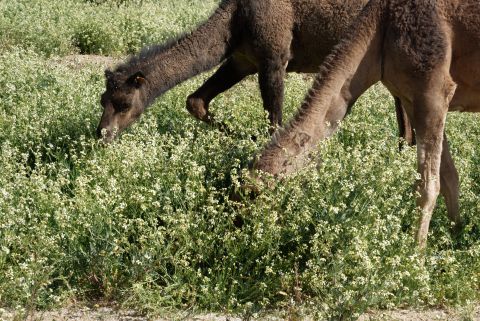



Les Eruca du Maroc oriental
The Eruca of eastern Morocco
--
« On the way from Oudjda to Naïma ... during our visit, the land subjected from time to time to plowing or more exactly to scratching, was literally covered with a small annual crucifer of yellowish-white color : Eruca sativa v. longirostris . We had never seen such masses of an annual species : it is by billions that it invades the plains, from Lalla-Marnia to El-Aïoun. »
Braun-Blanquet J. & Maire R., 1924 - Étude sur la végétation et la flore marocaines
Eruca longirostris Uechtritz
(Cette espèce est nommée Eruca sativa Mill. dans la Flore pratique du Maroc et Eruca vesicaria subsp. sativa (Mill.) Thell. dans l'African Plant database.(This species is named Eruca sativa Mill. In the "Flore pratique du Maroc" and Eruca vesicaria subsp. sativa (Mill.) Thell. in the African Plant database.)
C'est dans les mêmes plaines parcourues par Braun-Blanquet et Maire en 1924 que nous avons photographié cette roquette aux printemps 2020 et 2021 ; ces années n'avaient pas été très pluvieuses, les roquettes n'étaient pas très denses et ne dépassaient pas une hauteur de 20cm. Elles n'en formaient pas moins d'immenses tapis d'une couleur blanc-crème.
It is in the same plains traveled by Braun-Blanquet and Maire in 1924 that we photographed this rocket in the spring of 2020 and 2021 ; those years had not been very rainy, the rockets were not very dense and did not exceed a height of 20cm. They nevertheless formed immense carpets of a creamy white color.
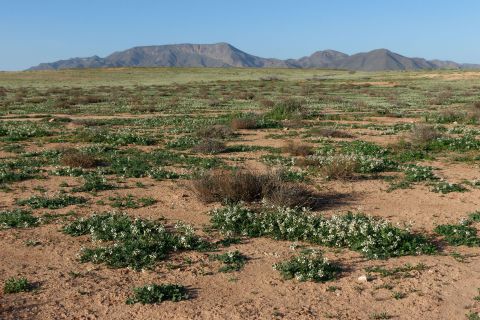
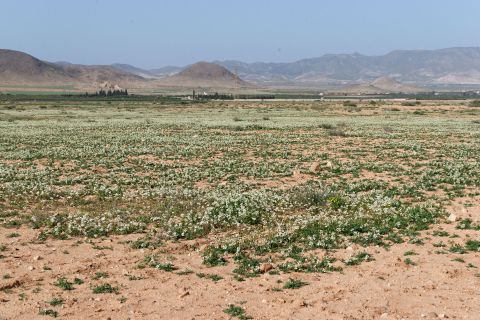
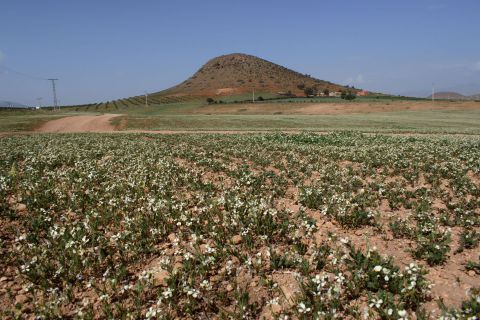
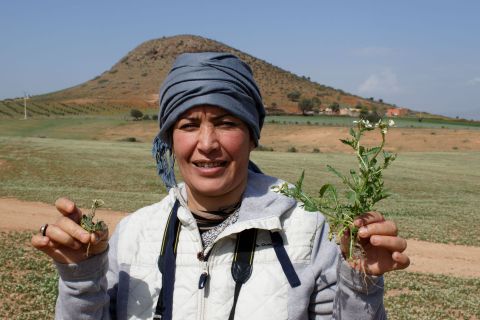
Nous avons retrouvé cette roquette dans le Haut-Atlas, vers Imilchil, à près de 2200m d'altitude, formant une auréole autour des prairies marécageuses gérées en Agdal.
We found this rocket again in the High Atlas, near Imilchil, at an altitude of almost 2200m, forming a ring around the marshy meadows managed as Agdal.
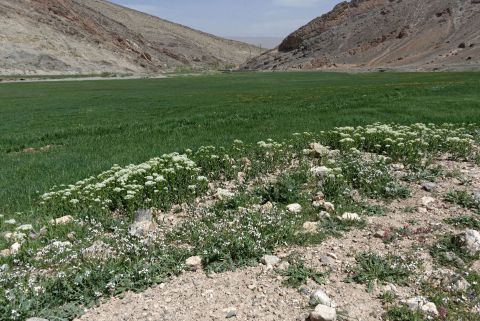
Autour de la prairie marégageuse il y a deux ceintures de crucifères : la ceinture intérieure est formée par Lepidium draba L. et la ceinture extérieure par Eruca longirostris Uechtr.
Sur la photo à droite, les siliques ont des valves poilues et des rostres très longs, ce qui élimine tout risque de confusion avec E. sativa Mill.
--
Around the marshy meadow there are two belts of crucifers : the inner belt is formed by Lepidium draba L. and the outer belt by Eruca longirostris Uechtr.
In the photo on the right, the pods have hairy valves and very long rostrums, which eliminates any risk of confusion with E. sativa Mill.
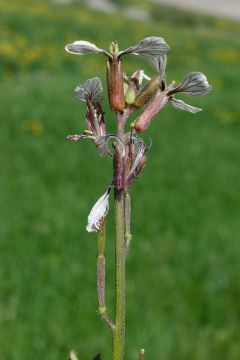
Contact longirostris/pinnatifida
Eruca longirostris est entrainée par les oueds jusqu'aux piémonts du Haut-Atlas où on peut la rencontrer en compagnie de Eruca pinnatifida. Nous n'avons pas trouvé de pieds hybrides entre ces deux taxons ce que nous utiliserons plus tard comme argument pour justifier que nous traiterons ces taxons comme des espèces distinctes.
Il faut noter les différences de couleur entre les populations du bord de la Méditerranée dont les fleurs sont blanc-crême, celles du Haut-Atlas blanc-pur et celles des piémonts jaune-pâle.
Eruca longirostris is carried by the wadis to the foothills of the High Atlas where it can grow in the company of Eruca pinnatifida . We did not find any hybrid plants between these two taxa which we will use later as an argument to justify that we will treat these taxa as distinct species.
Note the color differences between the populations on the edge of the Mediterranean whose flowers are creamy white, those of the High Atlas pure white and those of the foothills pale yellow.
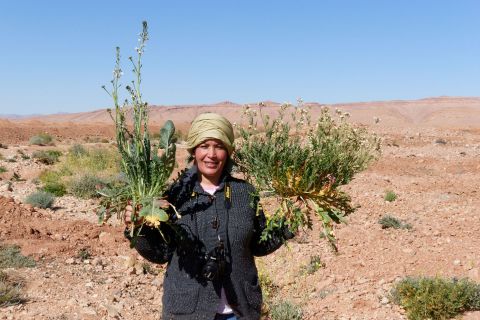
Eruca longirostris (à droite) se distingue immédiatement de E. pinnatifida (à gauche) par son port.
--
Eruca longirostris (right) is immediately distinguishable from E. pinnatifida (left) by its habit.
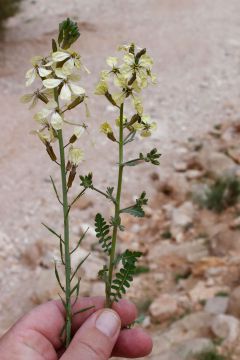
On reconnait à gauche E. pinnatifida aux boutons floraux qui dépassent longuement les fleurs épanouies. On reconnait à droite E. longirostris à ses petites feuilles caulinaires profondément découpées.
--
We recognize on the left E. pinnatifida with flower buds that protrude above the open flowers. We recognize on the right E. longirostris with its small, deeply indented stem leaves.
Eruca pinnatifida (Desfontaines) Pomel
Dans l'Est du Maroc, Eruca pinnatifida est une plante des zones de transition entre les végétations méditerranéennes et sahariennes. On la trouve au Sud des hauts-plateaux de l'Oriental dans les dernières steppes à alfa. Dans le Haut-Atlas oriental, on peut la trouver sur les pentes arides exposées au Sud jusqu'à 1800m d'altitude. Elle est particulièrement abondante dans les piémonts sahariens du Haut-Atlas oriental mais ne s'aventure pas dans le Sahara lui même.
Eruca pinnatifida se reconnait immédiatement à son port très vertical et à ses longues tiges florales qui mesurent le plus souvent 1m de haut mais peuvent dans de bonnes conditions dépasser 2m !
In eastern Morocco, Eruca pinnatifida is a plant from the transition zones between Mediterranean and Saharan vegetation. It is found in the south of the highlands of the Oriental in the last steppes covered with alfa. In the eastern High Atlas, it can be found on arid southern slopes up to 1800m altitude. It is particularly abundant in the Saharan foothills of the eastern High Atlas but does not venture into the Sahara itself.
Eruca pinnatifida is immediately recognizable by its very vertical habit and its long floral stems which are most often 1m tall but can in good conditions exceed 2m !
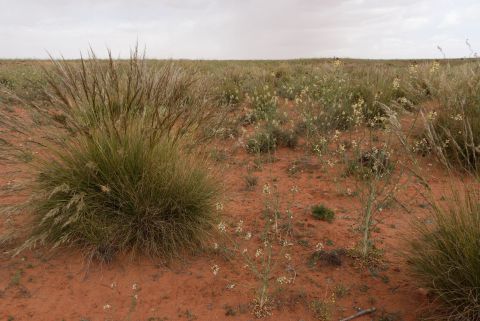
Colonisant les zones nues entre les touffes d'alfa dans le Sud des hauts plateaux de l'Oriental.
--
Colonizing the bare areas between the clumps of alfa in the southern highlands of the Oriental.
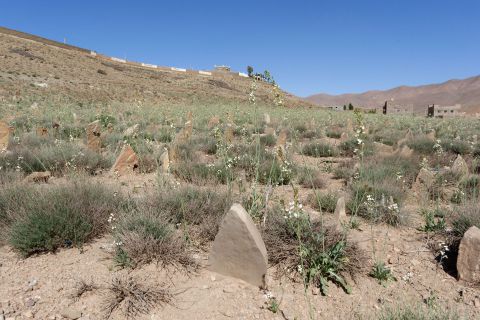
Colonisant les zones nues entre les touffes de Hammada scoparia dans un cimetière exposé plein sud dans la haute vallée de l'oued Todra.
--
Colonizing the bare areas between the clumps of Hammada scoparia in a cemetery facing south in the upper valley of Wadi Todra.
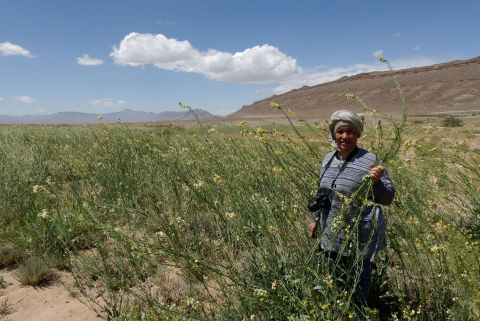
Sur les sols sablonneux de la vallée pré-saharienne entre Rich et Gourrama ; les zones de reg de cette vallée sont colonisées par Anabasis aretioides.Noter les tiges florales de plus de 2m de haut !
--
On the sandy soils of the pre-Saharan valley between Rich and Gourrama ; the reg areas of this valley are colonized by Anabasis aretioides . Note the flower stems over 2m tall !
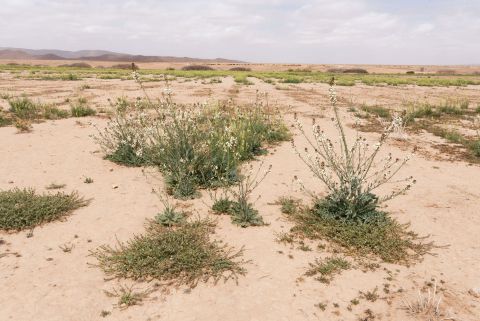
Contact pinnatifida/foleyi
Les grands épandages de Bouarfa et de la plaine de Tamlelt constituent la limite Sud de Eruca pinnatifida et la limite Nord de E. foleyi. Ces deux espèces cohabitent sans former de population hybride.
The large wadi beds of Bouarfa and the Tamlelt plain constitute the southern limit of Eruca pinnatifida and the northern limit of E. foleyi . These two species coexist without forming a hybrid population.
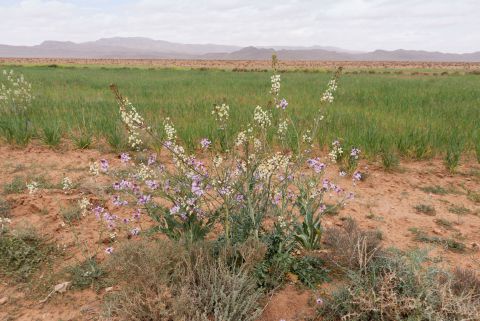
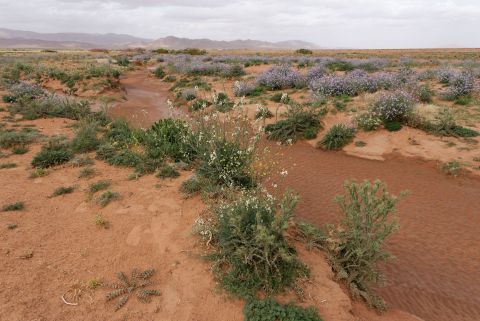
Eruca foleyi (Batt.) Perfectti
(Cette espèce est nommée Moricandia foleyi Batt. dans toutes les flores qui précèdent la révision du genre Moricandia par Perfectti en 2017.)(This species was named Moricandia foleyi Batt. in all the flora that precede the revision of the genus Moricandia by Perfectti in 2017.)
Eruca foleyi tranche par ses fleurs bleues parmi les autres roquettes. Mais pour s'assurer de son appartenance au genre Eruca, il suffit d'en croquer une feuille : son goût de roquette est encore plus prononcé que dans les espèces à fleurs jaunes.
Eruca foleyi stands out with its blue flowers among other rockets. But to be sure that it belongs to the Eruca genus, all you need to do is bite into a leaf : its rocket taste is even more pronounced than in species with yellow flowers.
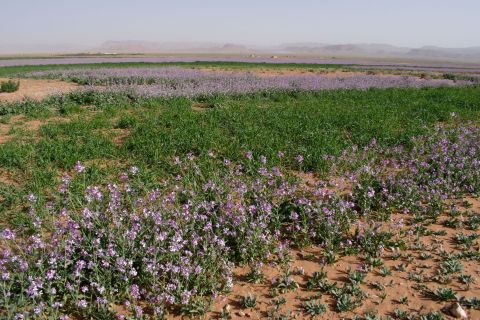
Ce n'est pas Euca foleyi qui est adventice autour des parcelles de blé, mais au contraire ce sont les parcelles de blé qui ont été semées dans un 'Erucetum'.
--
It is not Euca foleyi which is weed around the wheat plots, but on the contrary it is the wheat plots that have been sown in an 'Erucetum'.
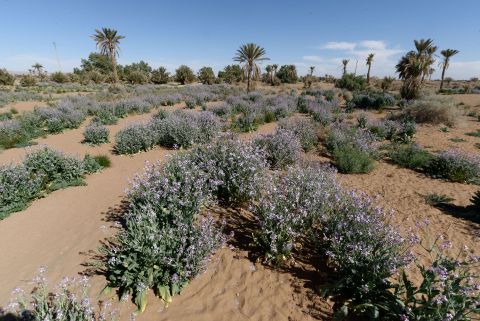
Magnifique station de Eruca foleyi dans le lit sablonneux d'un oued intermittent qui avait connu une crue après un orage en amont.
--
Magnificent station of Eruca foleyi in the sandy bed of an intermittent wadi which was flooded after a storm upstream.
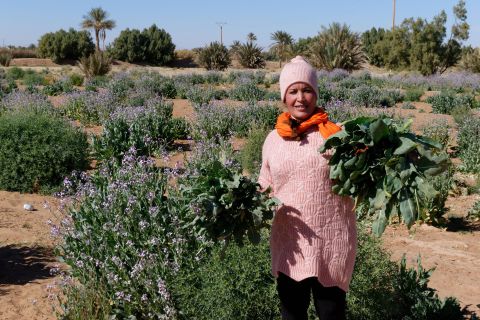
Les feuilles charnues de Eruca foleyi sont cueillies pour préparer des salades cuites. C'est un plat printanier traditionnel dans le Tafilalet.
--
The fleshy leaves of Eruca foleyi are picked to prepare cooked salads. It is a traditional spring dish in Tafilalet.
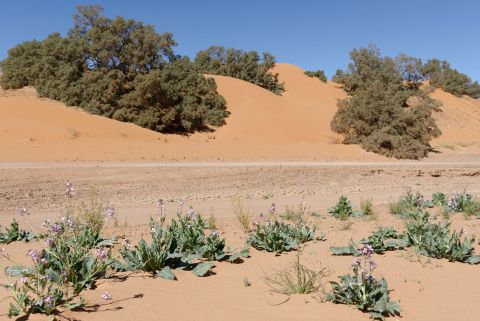
Contact foleyi/aurea
Au Maroc Eruca foleyi atteint sa limite Sud à la hauteur de Merzouga. Elle entre alors en contact avec Eruca aurea en formant de magnifiques populations mixtes de crucifères auxquelles participent aussi Diplotaxis virgata (Cav.) DC. et Zahora aït-atta Lemmel & M.Koch. Nous n'avons jamais trouvé de pieds hybrides entre ces différents taxons.
In Morocco Eruca foleyi reaches its southern limit at the latitude of Merzouga. It then comes into contact with Eruca aurea by forming magnificent mixed populations of crucifers in which Diplotaxis virgata (Cav.) DC and Zahora aït-atta Lemmel & M.Koch also participate. We have never found hybrid plants between these different taxa.
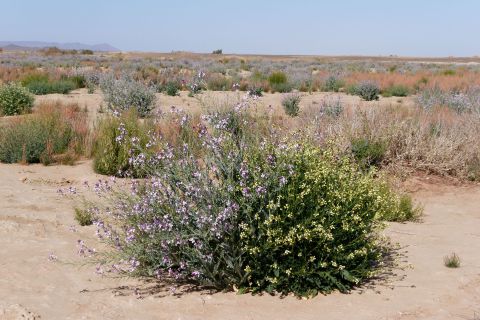
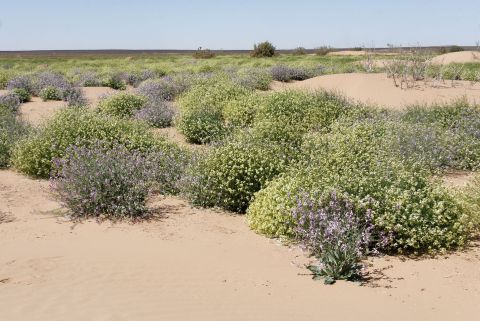
Eruca aurea Battandier
(Cette espèce n'est pas citée dans la Flore pratique du Maroc ; elle est assimilée de façon erronée à Eruca pinnatifida (Desf.) Pomel dans Med-Checklist ou dans l'African Plant Database.)(This species is not mentioned in the "Flore pratique du Maroc" ; it is erroneously assimilated to Eruca pinnatifida (Desf.) Pomel in Med-Checklist or in the African Plant Database.)
Nous donnons intentionnellement beaucoup de photos de cette espèce pour montrer son importance dans les paysages sahariens et sa différence de morphologie et d'écologie avec Eruca pinnatifida. Toutes ces photos sont prises dans le Tafilalet, mais Eruca aurea a une distribution très vaste. Vers le Sud-Ouest nous en connaissons des grandes populations jusque vers les oueds du Sahara océanique, dans la région de Smara. Vers le Sud-Est elle est attestée dans le Sahara central algérien jusqu'au Hoggar.
Au premier coup d'oeil Eruca aurea se distingue de Eruca pinnatifida par ses tiges rameuses, son port en boules sphériques, ses tiges plus courtes munies de grandes feuilles caulinaires à leur base.
We intentionally give a lot of photos of this species to show its importance in Saharan landscapes and its difference in morphology and ecology with Eruca pinnatifida . All of these photos are taken in Tafilalet, but Eruca aurea has a very wide distribution. Towards the southwest we know large populations of them as far as the wadis of the oceanic Sahara, in the region of Smara. Towards the south-east it is attested in the central Algerian Sahara as far as Hoggar.
At first glance Eruca aurea is distinguished from Eruca pinnatifida by its branching stems, its shape in spherical balls, its shorter stems with large cauline leaves at their base.
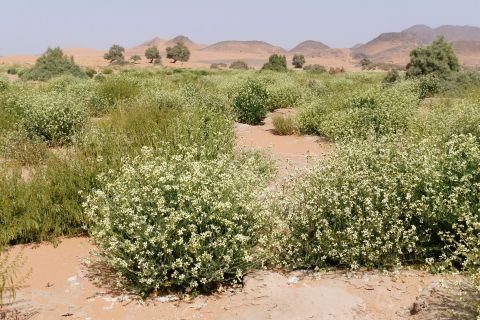
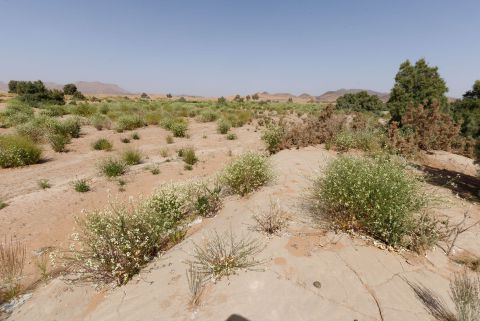
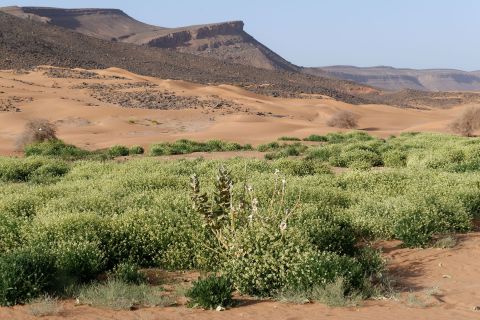
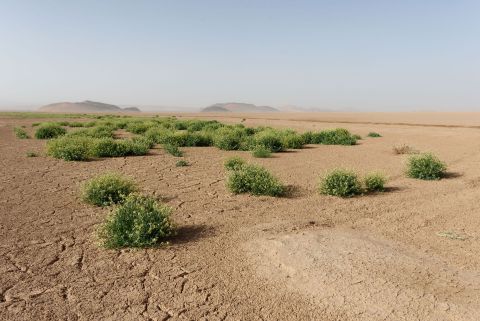
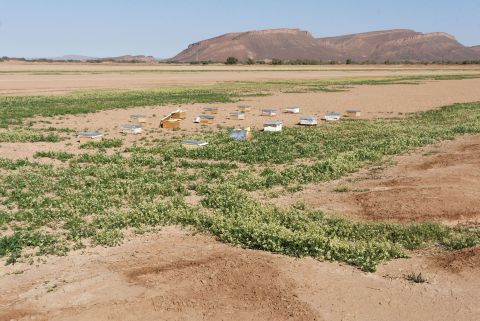
En fin d'hiver les apiculteurs transhumants viennent depuis le Nord du Maroc installer leurs ruches par centaines dans les épandages de roquette.
--
At the end of winter, transhumant beekeepers come from the north of Morocco to install their hives by the hundreds in the rocket fields.
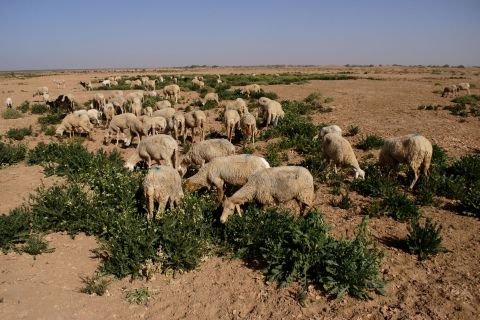
Les roquettes attirent les troupeaux de moutons venus du Nord...
--
Rockets attract flocks of sheep from the North ...
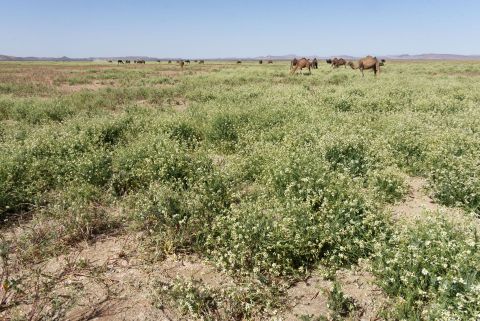
...et les troupeaux de dromadaires venus du Sud !
--
... and the herds of camels from the South !
